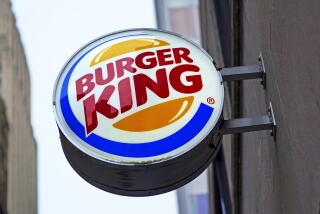A Sure Way to End Up With a Cover Story : Critics Question Magazines Putting Firms Out Front
- Share via
Acme Brick Co. hardly sounds like a candidate for the cover of Sports Illustrated.
But it’s been there. Four times in the past year, to be precise.
The Ft. Worth, Tex.-based brick maker doesn’t manufacture athletes--or athletic equipment, for that matter. Acme Brick--along with a number of companies from Airbus Industrie to Dow Plastics--has signed on to a provocative promotional program at Time Inc. Magazines that gives companies the opportunity to have their names, logos and sometimes even their products appear on mock magazine covers. The covers are then wrapped around the real covers of the magazines and sent to the firms’ best business customers. The fake covers even carry the exact logos from Time, Life, Money and other magazines owned by the media giant.
Some critics contend the promotional gimmick is confusing at best and deceptive at worst.
“How far are magazines willing to go to prostitute themselves?” said Samir Husni, editor of “Samir Husni’s Guide to New Consumer Magazines” and a journalism professor at the University of Mississippi. “The more the established media is hurting for ad money, the more gimmicks it will come up with.”
Such promotion has grown more popular at a time when the magazine industry’s ad revenue growth has greatly slowed and its number of ad pages sold is down 1.5% for the first nine months of 1993 compared to 1992, according to the Publishers Information Bureau.
With the continued growth of promotional techniques, “the function of magazines is no longer to deliver news but to sell advertising,” said Sut Jhally, professor of communications at the University of Massachusetts at Amherst.
But executives at Time Inc. Magazines insist they’re not selling out. They note that plenty of magazines now wrap ads in paper or plastic around their covers. Besides, they say, these special issues are sent only by businesses to other businesses, not to consumers. And without the logos across the front of the mock covers, the magazines wouldn’t qualify for second-class postage.
“We make it very clear (to consumers) that they are reading a special message,” said Michele Jaworski, general manager at Money magazine. “Advertisers cannot buy the cover of Money magazine.”
“There is no intent to deceive anyone,” Time magazine spokesman Robert Pondiscio said of its mock covers bought by advertisers.
“It’s like gift wrapping,” said Roger Jackson, a spokesman for Sports Illustrated. “It can’t possibly be confused with the real cover.”
As far as Acme Brick executives are concerned, their promotional-cover program with Sports Illustrated has been a real winner.
“We’re just a little brick company,” said Bill Seidel, director of marketing at Acme, “but when our customers see these covers, they think we’re marketing the heck out of the product.”
Around Christmastime, Acme sends annual gift subscriptions of Sports Illustrated to 1,100 of its best clients, as well as customers it hopes to land. For the $60,000 it spends on the promotion, it also gets to have its name and products appear four times annually on special covers wrapped around issues sent only to the customer list that Acme supplies to Sports Illustrated.
Executives at Airbus Industrie, a European airplane manufacturing consortium, say their promotion with Time magazine is highly successful in getting 1,000 of their best clients--and potential new customers it is trying to recruit--to read about the firm. The Airbus cover of Time is royal blue, with the magazine’s logo on the top and the Airbus logo in smaller print underneath it. In tiny print at the bottom of the cover is a disclaimer from Time saying the special cover “does not constitute an endorsement by Time.”
“Most people tell us they have never seen such a thing,” said David Venz, vice president of communications at Airbus Industrie. He said many clients who receive these special issues tell them they think all Time subscribers see the same Airbus cover. “They thought we were spending millions of dollars,” he said.
Dow Plastics has a similar program with Money magazine. The covers not only feature the Dow logo, but also flashy pictures of plastic products made by Dow.
There is a positive rub-off effect of showing up on the front of Money magazine, said Tina Ludington, a spokeswoman for Dow Plastics. “We’re being associated with the high quality of the magazine.”
The person who devised these magazine cover promotions is E. William Kenyon, president of Targeted Media, a subsidiary of Time Inc. Magazines.
“It’s not as if we’re taking the covers off and replacing them--we’re just wrapping something around them,” said Kenyon, a former associate publisher at Fortune magazine. “It doesn’t impinge on the editorial integrity of the magazines.”
But the mock covers are not without risks, say magazine industry consultants.
“People don’t like to be fooled,” said Philip W. Sawyer, editor of “Tested Copy” a newsletter distributed by Roper Starch Worldwide, a Mamaroneck, N.Y., research firm. With these promotions, that’s precisely what some advertisers are trying to do to readers, he said.
If the cover promotions prove to be so successful with business-to-business advertisers, the big consumer advertisers may also soon demand it, said Dan Capell, managing director of New York-based Vos, Grouppo & Capell. “What is Time going to do when General Motors comes along and says: ‘I’m your biggest advertiser. I want you to do that for me--for free.’ ”
Briefly . . .
The Venice ad agency Chiat/Day is in the running for Cherry Coke’s multimillion-dollar ad account, previously handled by the New York agency McCann-Erickson. . . . The Los Angeles office of D’Arcy, Masius, Benton & Bowles has picked up the $13-million account to create ads for Glendale-based Baskin-Robbins ice cream, formerly handled by the Los Angeles agency Asher/Gould. . . . Fullerton-based Home Base has awarded its $20-million broadcast ad account to Los Angeles-based Lord, Dentsu & Partners and its $20-million media buying account to Los Angeles-based International Communications Group.
Hungry for Ads
Many of the nation’s biggest consumer magazines saw their ad revenues dip or grow slowly for the first nine months of 1993. As a result, an increasing number are turning to unusual ad promotions to boost revenue. Here is how the Top 10 magazines fared from January through September.
1993 ad 1992 ad revenue revenue Percent Rank Magazine (millions) (millions) change 1 People 244.1 247.5 -1.4% 2 TV Guide 228.1 198.1 +15.1 3 Time 225.2 237.7 -5.2 4 Sports Illustrated 210.7 225.3 -6.5 5 Newsweek 168.3 171.1 -1.6 6 Good Housekeeping 144.9 135.2 +7.2 7 Business Week 139.9 142.1 -1.6 8 Better Homes & Gardens 136.5 130.5 +4.6 9 U.S. News & World Report 130.8 129.9 +1.9 10 Forbes 115.5 115.3 +0.2
Source: Publishers Information Bureau and Media Industry Newsletter
More to Read
Inside the business of entertainment
The Wide Shot brings you news, analysis and insights on everything from streaming wars to production — and what it all means for the future.
You may occasionally receive promotional content from the Los Angeles Times.










